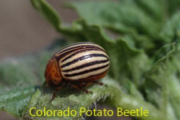 Overwintering females emerge in late April and lay a cluster of bright, yellow eggs on recently emerged potato plants. Larvae mature in about 3 weeks and pupate in the soil. After another 10 days, adult beetles emerge, mate and lay more eggs. Both larvae and adults of this insect feed on potato (as well as tomato, eggplant, and pepper), causing extensive loss of foliage and reducing yields. Control strategies are varied and include: - Hand picking: Useful for small gardens where plants can be checked a couple of times a week. Dropping beetles and larvae in a container of soapy water will lead to their demise. - Floating row cover: This material can be placed over the planting and act as a physical barrier to the insects. Be sure to seal the edges. It is sometimes suggested to leave the floating row cover in place during the growing season because potatoes do not need to be pollinated to produce tubers. Often, this is not practical because it interferes with weed control. - Insecticides: A number of products are registered including the organic control spinosad (Fertilome Borer, Bagworm, Leafminer and Tent Caterpillar Spray and Bonide Colorado Potato Beetle Beater Concentrate) and more conventional insecticides permethrin (numerous trade names) and lambda- or gamma-cyhalothrin (Bonide Beetle Killer, Spectracide Triazicide). (Ward Upham) 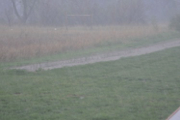 What do you do when the lawn can't be cut because of constant rain? The best thing to do is to set your mower as high as possible and bring it down in steps. It is always best never to take more than one third of the grass blade off at one time. If more is taken, the plant reacts by using stored energy reserves to quickly send up new growth. This reduces the amount of energy available for the plant to deal with stress or damage done by insects or disease. However, sometimes it is just not possible to keep the "one-third rule." In such cases, cut as high as possible even though it may mean you are cutting off more than one third of the blade. Bring the height down gradually by cutting more often and at progressively lower heights until you reach the target height. (Ward Upham) 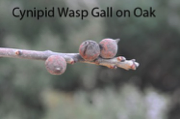 A number of tiny non-stinging wasps, mites and flies cause abnormal growths to develop on the leaves, twigs or branches of oak trees. These galls can include growths that are round, spiny, flattened, elongated or star-shaped. There are hundreds of different types of galls, each of which is caused by a specific insect. Galls form in response to a chemical that the insect injects into the plant tissue. Mature females lay eggs that hatch into legless grubs. Galls form around them. Larvae feed, develop, and pupate inside these galls. Adults may emerge either the same season or may overwinter inside the gall depending on the life history of that specific insect. Generally, these gall insects do not cause significant damage to their hosts, though some of the leaf galls can cause enough deformity to make a tree unsightly. Also, severe infestations of twig galls can cause twig dieback or, rarely, tree death. However, just because a twig is covered with galls does not mean it is dead. I have seen twigs that looked like a solid mass of galls leaf out in the spring. Insecticide sprays applied when galls are noticed are ineffective because damage has already occurred. Also, larvae are unaffected because of the protection afforded by the gall. Insecticide sprays can kill emerging adult wasps and flies, but long periods of emergence and short residuals of most contact insecticides make this impractical. Stem and twig galls can be pruned if deemed to be practical and necessary. In short, this is a problem that is best ignored unless pruning is done to improve the appearance of the tree. (Ward Upham) Some areas of Kansas have had saturated or near-saturated soils for several weeks now. Gardeners are likely to assume that watering won’t be needed for quite some time now as soil moisture levels are very high. Actually, watering may be needed much sooner than you expect.
Excessive rain can drive oxygen out of the soil and literally drown roots. Therefore, as we enter hotter, drier weather, the plants with damaged root systems may be very susceptible to a lack of water. Don’t forget to check your plants for signs of wilting or leaf scorching and water as needed. If irrigation is called for, water deeply and infrequently. Usually once per week is sufficient depending on the weather. Soil should be moist but not waterlogged. (Ward Upham) 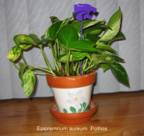 We are approaching the time of year when many people take vacation. In the rush to get everything done before leaving, don't forget your houseplants will probably need watering while you are gone. The best alternative is to have someone water them for you. However, if this is not possible, there are alternatives. 1. Well-watered plants can be placed inside a plastic bag. Prop up the bag by using wooden dowels or something similar to keep the plastic off the leaves. Make sure the enclosed plants will not receive full sun as heat buildup may cook them. Bright, indirect light is best. Plants should keep for about a week with this method. 2. This method requires an old dish drying rack, a bathtub in a bathroom with some natural light and some shoelaces. Place the drying rack upside down in the tub and add several inches of water. Push one end of a shoelace through a drainage hole on the bottom of a pot and into the potting soil of your houseplant. The other end of the shoelace dangles into the water. What you have made is a wick system that will replace water in the pot as the plant uses it. Plants can last a couple of weeks if you have enough natural light. 3. There are numerous commercial products that can be used to automatically water houseplants in your absence. The advantage of these products is that the houseplant does not normally need to be moved. All require a reservoir from which water is either siphoned or pumped to individual houseplants. Houseplants should last as long as the water holds out. (Ward Upham) Gregg Eyestone, Horticulture Agent from Riley County, has put together a nice chart that covers sidedressing nitrogen on annual flowers, certain perennial flowers, vegetables and various small fruit. Sidedressing (also called topdressing) is applying nitrogen fertilizer as plants are growing to give them an extra boost. Done correctly, sidedressing can improve vegetable, fruit and flower production. Gregg lists the crop, the amount of fertilizer needed, and suggested time of application. Rates are given for ammonium sulfate, urea and blood meal. You may find the chart at http://tinyurl.com/hxtgres (Ward Upham)
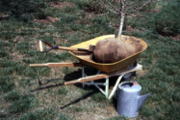 Cathie Lavis, our Landscape Specialist has authored a new publication on planting trees. This is a two-page publication with the first page covering the proper planting of a ball-in-burlap tree, and the second page covering container-grown trees. If you want a newly planted tree to survive and thrive, proper planting is vital. You can find the publication at: https://www.bookstore.ksre.k-state.edu/pubs/MF3313.pdf (Ward Upham) The Johnson County Extension Master Gardeners, along with the Midwest Regional Hosta Society, are pleased to host the 2017 conference in Lenexa, Kansas June 22 – 24, 2017. This is the first time in the history of the organization that a hosta convention has been held in the state of Kansas. The three-day event features something for all gardening enthusiasts. Day one is education. A series of classes will be held on a variety of topics from hostas to general gardening. Day two are garden tours in the Topeka, Kansas area. These include beautiful estate landscapes, as well as stop at historic Ward Meade Park and a visit to the only American Hosta Display Garden in the region. Day three is garden tour day in Johnson County. Unique gardens, ranging from a Japanese garden to a conifer garden. There will also be a tour of the only hosta tissue culture lab in the region. Other highlights include a hosta leaf and design show, banquet speakers and a rare plant auction. Complete information can be found at www.2017kchostaconvention.com or by calling the Johnson County Extension Office, 913-715-7000
|
AuthorsCynthia Domenghini runs the Horticulture Response Center in the Department of Horticulture and Natural Resources at Kansas State University. Other contributors include K-State Extension Specialists. Archives
March 2024
Categories
All
|
| K-State Research and Extension Horticulture Newsletter |
|
 RSS Feed
RSS Feed
